Menus
- A piece of art history
- The steering angle is happily larger
- The Bimota Tesi 3D Mono is extremely handy
- facts and figures
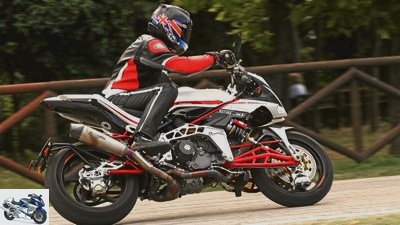
Cathcart
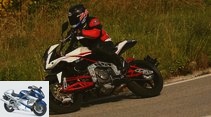
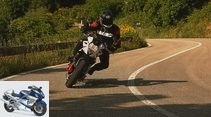
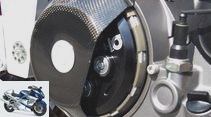
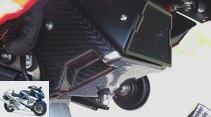
14th photos
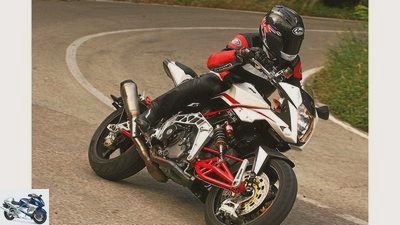
Cathcart
1/14
Bimota importer Benny Wilbers: "A Bimota Tesi is art on wheels."
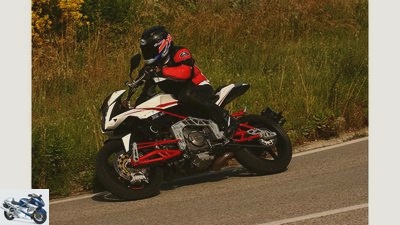
Cathcart
2/14
The feedback from the front wheel is also surprisingly good.

Cathcart
3/14
When braking hard before bends, it is simply an event how the sensitive front soaks up the bumps.
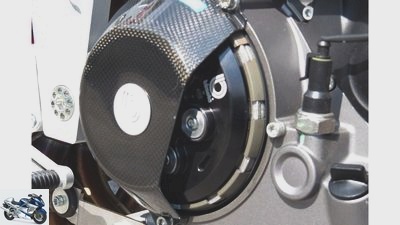
Fig
4/14
It has an air-cooled two-cylinder four-stroke 90-degree V-engine.
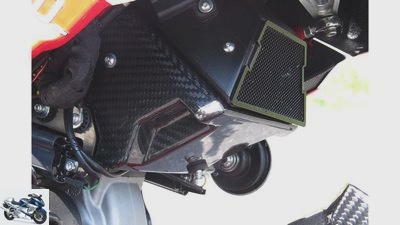
Fig
5/14
The Bimoa Tesi 3D Biposto now costs 29,990 euros.
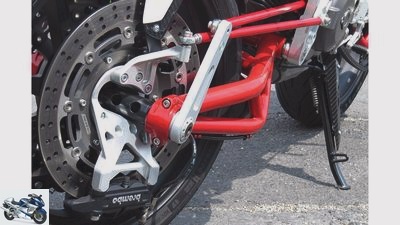
Fig
6/14
Please take a closer look, you don’t see wheel hub steering like this every day – an elaborate, fascinating piece of technology.

Fig
7/14
The Mono is characterized by clip-ons and an underseat exhaust.
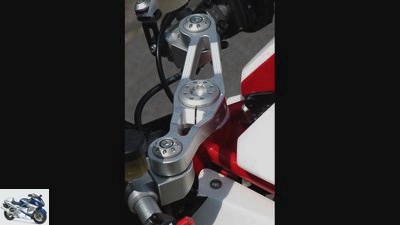
Fig
8/14
Filigree fork bridge that appears to float freely.
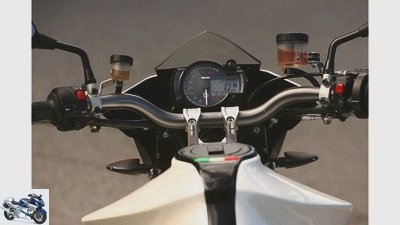
Cathcart
9/14
The easy-to-read cockpit is already familiar from other Bimotas.
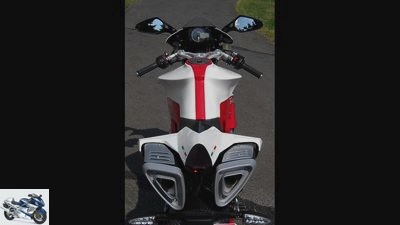
Fig
10/14
The cockpit of the Bimota Tesi.
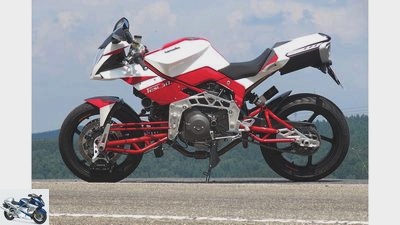
Fig
11/14
In contrast to the first Tesi, the 1D, the 3D carries the thrust struts of the wheel hub steering on the left.

Fig
12/14
Whichever angle you look at the Tesi from, it is incredibly delicate and slim.
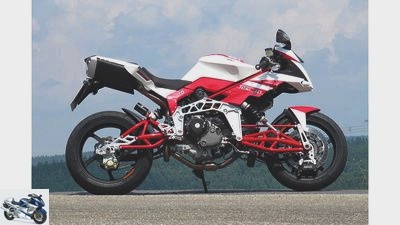
Fig
13/14
The Bimota Tesi produces 98 hp.
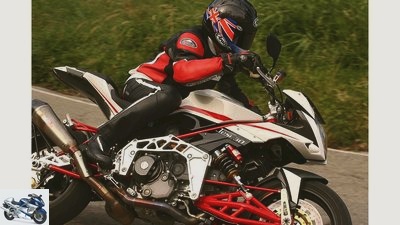
Cathcart
14/14
The active Tesi is a fascinating piece of technology and Bimota history at the same time.
Bimota Tesi 3D Biposto / Mono in the driving report
A piece of art history
The Bimota Tesi is a piece of two-wheeled art. And when it appeared in 1991, it cemented the brand’s reputation as a high-end chassis manufacturer. With the latest variant, the Bimota Tesi 3D Biposto / Mono, and a new importer, the brand wants to build on the glamorous times again.
Potente Japanese four-cylinder in both exclusive and beautifully crafted tubular tubular chassis – these were the ingredients from which Bimota’s legendary reputation grew in the seventies. But lately the Italians have been very quiet.
Buy complete article
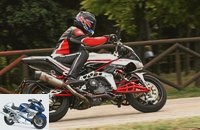
Bimota Tesi 3D Biposto / Mono in the driving report
A piece of art history
Bimota more active than ever
After eventful years with ups and downs, Bimota is now more active than ever. Chassis expert Benny Wilbers, who takes on the original equipment of the chassis, acts as the importer of the noble racers from Rimini, which today are powered exclusively by Ducati engines. This should ensure that sales are in solid hands and ensure sustainability. Wilbers plans to build up a close-knit dealer network with 50 to 60 dealers in Germany and other German-speaking countries as well as in Holland and Belgium.
MOTORRAD employee Alan Cathcart drove the two-seater variant Bimota Tesi 3D Biposto in Italy. Undoubtedly the technical highlight in the Bimota range with its wheel hub steering. With it, Bimota owner Roberto Comini wanted to create a reinterpretation of the original Bimota Tesi 1D in 2008 and at the same time free it from some of the shortcomings with which the original Tesi was afflicted. Like the very small steering angle, for example. Or the unfortunate position of the front shock absorber, which came into contact all too easily with the driver’s knee.
The steering angle is happily larger
And now, with a few detailed changes, the latest Tesi variant, which was already on view at the Eicma in Milan last year, is ready. Aluminum profiles milled from the solid enclose Ducati’s air-cooled Desmodue. They don’t just take the front and rear swingarms. The front subframe, which carries the steering head, is bolted there, as is the rear. For the first time on a Tesi, this now also offers space for a passenger. The Zard underseat mufflers of the single-seat Bimota Tesi 3D Mono had to give way. They are being replaced by an Arrow two-in-one system. Compared to the original Tesi, the steering angle of 23 to 17 degrees is happily larger, which makes turning and maneuvering much easier. In conjunction with the wide aluminum handlebar, the new Bimota Tesi can be maneuvered much more easily in the maze of cities or on winding streets in the hinterland.
No matter from which angle you look at the Bimota Tesi 3D, it is incredibly delicate and slim. And thanks to the low seat height of 780 millimeters, the Tesi integrates its driver perfectly. The wheelbase is outrageously short at 1390 millimeters, the weight distribution is balanced, and the low weight – the brochure data speak of 170 kilograms dry – promise charming handling. And really, excited from the first meter, how relaxed it can be moved. She follows the commands on the wide handlebars almost intuitively.
The Bimota Tesi 3D is a manoeuvrable, agile curve predator that longs to be thrown from one lean angle into the next. The nimble, yet stable steering behavior and the excellent brake cocktail consisting of two floating 320 mm brake discs from Braking and – for the first time in a machine with wheel hub steering – radially mounted Brembo calipers create the necessary confidence.
Fig
The Bimota Tesi 3D produces 98 hp.
The Bimota Tesi 3D provides significantly more feedback from the front wheel than the original Tesi, which is due not least to the newly arranged steering geometry of the lever of the wheel hub steering and the pivot point of the front wheel swing arm. The steering head angle and caster can be between 72 and 64 degrees and 80 to 120 mm, respectively adjust – in this case they were 70 degrees and 106 millimeters. Certainly extreme values for conventional motorcycles. But they work perfectly here.
The biggest advantage of the wheel hub steering, however, is that you can brake very late and very hard into undulating corners. By separating the steering and suspension, this system offers, similar to a Telelever steering from BMW, an – incidentally adjustable – brake buckling compensation. The front of the Bimota Tesi 3D is hardly immersed when braking, and the suspension travel is largely retained during braking maneuvers to absorb waves. And in conjunction with this wonderfully high-torque Ducati twin, this results in an extremely powerful combination for robbing small, winding country roads.
MOTORRAD was then able to convince itself of this exclusively. Because in time for this report, the new Bimota importer Benny Wilbers brought a single-seater Bimota Tesi 3D Mono to the Nurburgring to make the winding Eifel streets unsafe.
The Bimota Tesi 3D Mono is extremely handy
With the standard, slightly flatter steering head angle (67 degrees) and already equipped with Wilbers suspension elements – the Biposto still wore Italian ExtremeTech suspension struts – the Bimota Tesi 3D Mono greedily assaults the endless series of curves. This light, delicate creation is simply wonderfully easy to handle from the cradle. Wilbers had deliberately chosen the tuning of the spring elements to be soft – not a disadvantage on the partly heavily pitted road surfaces – but the 3D Mono still runs its course extremely smoothly and stably.
Cathcart
The easy-to-read cockpit is already familiar from other Bimotas.
When braking hard before cornering, it is simply an event how the sensitive front soaks up the bumps in itself. In addition, the Bimota Tesi 3D Mono shines with enormous braking stability. Even if the front tire is already reaching its limit with a noticeable whimper. The STM slip clutch made an excellent impression. The feedback from the front wheel is also surprisingly good. A neatly coordinated fork certainly offers even more of this and also manages jagged lean changes with greater precision. But the complex wheel hub steering is definitely more spectacular. The Tesi is also and above all a technical work of art. One that wags through the curves with playful ease.
Basically, it finds an adequate partner in the air-cooled Ducati Twin, which with full thrust from the corners provides the punch in exactly the right place, namely at medium speeds. What makes surfing the torque wave with the lightweight a pleasure. City centers or traffic in a row, on the other hand, are less suitable for him. Annoying constant jerking showed that the set-up still needs some fine-tuning. Apart from that, the active Bimota Tesi 3D Mono is a fascinating piece of technology and Bimota history at the same time. With which the Italian premium brand is back again.
facts and figures
Fig
Please take a closer look, you don’t see a wheel hub steering system like this every day – a complex, fascinating piece of technology.
engine
Air-cooled two-cylinder four-stroke 90-degree V-engine, one overhead, toothed belt-driven camshaft, two valves per cylinder, desmodromic actuation, wet sump lubrication, injection, Ø 45 mm, regulated catalytic converter, 520 W alternator, 12 V / 10 Ah battery, hydraulically operated multi-plate dry clutch, six-speed gearbox, O-ring chain.
Bore x stroke: 98.0 x 71.5 mm
Displacement: 1079 cm³
Compression ratio: 10.7: 1
Rated output: 72.0 kW (98 hp) at 7500 rpm
Max. Torque: 105 Nm at 5500 rpm
landing gear
Bridge frame made of aluminum, wheel hub steering, central spring strut, lever system, adjustable spring base, rebound and compression damping, tubular steel frame, central spring strut, directly hinged, adjustable spring base, rebound and compression damping, double disc brake at the front, Ø 320 mm, four-piston fixed calipers, disc brake at the rear, Ø 220 mm, two-piston fixed caliper.
Cast aluminum wheels: 3.50 x 17; 5.50 x 17
Tires: 120/70 ZR 17; 180/55 ZR 17
mass and weight
Wheelbase 1390 mm, steering head angle 67.0 degrees, spring travel f / h 115/130 mm, dry weight 170 kg (Mono: 167 kg), tank capacity 16.0 liters.
Guarantee: two years
Price Bimota Tesi 3D Biposto: 29,990 euros (Bimota Tesi 3D Mono: 28,990 euros)
Related articles
-
Jahn driving report Bimota Tesi 2D Tecnologia dell´Emozione Two years ago the small Italian company VDM, like Bimota in Rimini, introduced the …
-
Jahn driving report Bimota DB7 lightning fast precious genius and madness ?? Bimotas, which were made before 2000, carried both in about equal parts …
-
Gori driving report Bimota Tesi 3D Tesi is alive For a good 20 years, the high-class forge from Rimini has been trying its hand at motorcycles without a telescopic fork. Can the new Tesi …
-
Technology highlights: Bimota Tesi, Honda NR 750, Norton TT
Jahn Technology highlights: Bimota Tesi, Honda NR 750, Norton TT Techno motorcycle The pace of further development in two-wheelers is getting faster and…
-
Driving report Bimota Vdue Evoluzione
Driving report Bimota Vdue Evoluzione The second The Vdue is alive, this time with carburetors instead of capricious direct injection. Exclusive driving impressions from …
-
Driving report Bimota DB6 Delirio
Edge driving report Bimota DB6 Delirio Hol-Delirio There comes joy! Bimota’s new weapon is sensationally radical: light, agile and trendy. With the…
-
On the move with Majestic 350 from 1930 and Bimota Tesi 1D-SR from 1992
41 photos r-photography.info 1/41 Picture gallery: Majestic 350 from 1930, Bimota Tesi 1D / SR from 1992. r-photography.info 2/41…
-
Bimota BB3 in the driving report
Bimota 35 photos Bimota 1/35 Bimota BB3 in the driving report. Bimota 2/35 Bimota BB3 in the driving report. Bimota 3/35 The handlebar of the Bimota BB3….
-
Driving report Bimota SB 8 R (1998) Quick Silver It is already fast, it is still silver-colored, soon it will – admittedly in a completely different decor – be …
-
Driving report Kawasaki ZZR 1400
Artist Driving report Kawasaki ZZR 1400 (2006) Full program With the ZZR 1400, performance is program: 200 HP make it the most powerful series machine of…